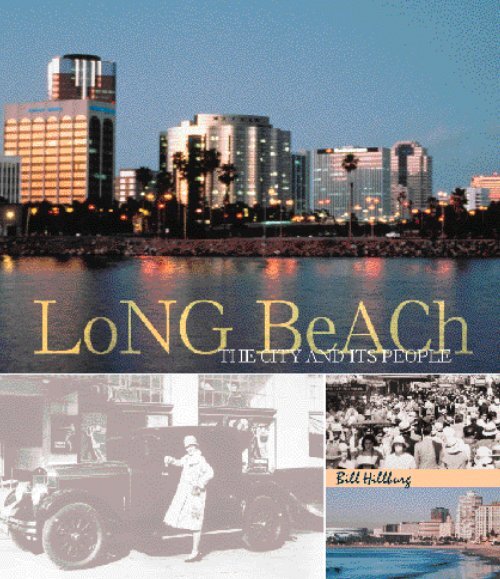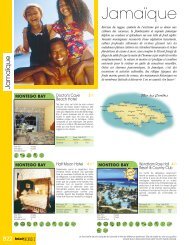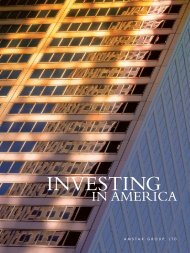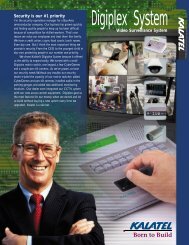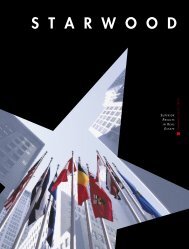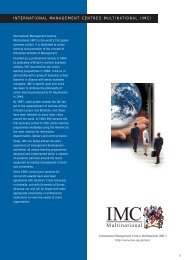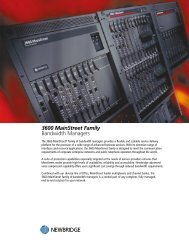You also want an ePaper? Increase the reach of your titles
YUMPU automatically turns print PDFs into web optimized ePapers that Google loves.
<strong>Bixby</strong> <strong>Land</strong> <strong>Company</strong><br />
Lewellyn <strong>Bixby</strong> stands before<br />
the family company’s offices<br />
on the day before his death<br />
in 1896.<br />
<strong>The</strong> <strong>Bixby</strong> <strong>Land</strong> <strong>Company</strong> has<br />
been shaped by the volatility of world<br />
events and the determination of rugged<br />
individuals. <strong>The</strong> <strong>Bixby</strong> family, one of the<br />
first names in California real estate, once<br />
owned or controlled the land now occupied<br />
by the cities of Long Beach, Los<br />
Alamitos, Seal Beach, Bellflower and<br />
Paramount.<br />
California real estate has changed<br />
considerably since the <strong>Bixby</strong>s began<br />
investing here well over 100 years ago.<br />
<strong>The</strong> core values of the <strong>Bixby</strong> <strong>Land</strong><br />
<strong>Company</strong>, however, have remained intact. <strong>The</strong> company is<br />
dedicated to the highest standards of ethics and integrity.<br />
It takes pride in its pro p e rties and cares about its employees,<br />
tenants and vendors.<br />
<strong>Bixby</strong> <strong>Land</strong> <strong>Company</strong>’s long history confers a maturity<br />
that can be acquired in no other way. With its understanding<br />
of the marketplace and long-term perspective,<br />
the firm balances a pro g ressive outlook with well-founded,<br />
conservative business principles.<br />
<strong>The</strong> <strong>Bixby</strong> migration to California began with a<br />
cousin, Benjamin Flint, who traveled west with the first<br />
wave of the gold rush in 1849. Lewellyn <strong>Bixby</strong> and his<br />
cousin, Thomas Flint, arrived in 1851 to join Thomas’<br />
brother, Benjamin, and seek gold. Lewellyn’s brother,<br />
Jotham <strong>Bixby</strong>, came the following year. <strong>The</strong> men soon<br />
re a lized the pitfalls of prospecting and opened a butcher<br />
shop. <strong>The</strong>y were successful and saved their money to<br />
begin an epic voyage and new business partnership. After<br />
traveling home to Maine, the <strong>Bixby</strong>s and Flints formed<br />
Flint, <strong>Bixby</strong> & Co. in 1853. <strong>The</strong> new company purchased<br />
about 2,000 sheep in the Midwest, and the men drove the<br />
herds across the country to California.<br />
To graze its herds, the company purchased Rancho San<br />
Justo near present-day Hollister in 1855. <strong>The</strong> Civil Wa r<br />
b rought an increased demand for wool and Flint, <strong>Bixby</strong> &<br />
Co. pro s p e red. <strong>The</strong> company b o u g h t<br />
Rancho Los Cerritos in Southern California<br />
to expand its pasture lands in 1866.<br />
Jotham <strong>Bixby</strong>, who had been mana<br />
g i n g Los Cerritos, exercised a purchase<br />
option in 1869. His firm, J. <strong>Bixby</strong> & Co.,<br />
operated the pro p e rty and was half<br />
owner along with Flint, <strong>Bixby</strong> & Co. A<br />
year later another adventurous cousin,<br />
John <strong>Bixby</strong>, came west to help Jotham.<br />
John <strong>Bixby</strong> worked at Los Cerr i t o s<br />
until he leased a ranch of his own —<br />
Rancho Los Alamitos — southeast of Los<br />
C e rritos, and moved there with his family in 1878. <strong>The</strong> two<br />
ranches were originally part of the vast Nieto Spanish land<br />
grant of approximately 165,000 acre s .<br />
Five years later, John <strong>Bixby</strong> purchased the ranch by<br />
p a rtnering with J. <strong>Bixby</strong> & Co. and Isaias Hellman, pre s ident<br />
of Farmers & Merchants Bank in Los Angeles. Each partner<br />
owned one-third of the ranch, and John lived there with<br />
his family and managed the pro p e rty under the name of<br />
J . W. <strong>Bixby</strong> & Co.<br />
John <strong>Bixby</strong> died in 1887, one year before the form ation<br />
of Alamitos <strong>Land</strong> <strong>Company</strong>. Alamitos <strong>Land</strong> <strong>Company</strong> was<br />
established to subdivide land and sell parcels for re s i d e ntial<br />
development. Shortly before John’s estate was settled in<br />
1891, Rancho Los Alamitos was further divided into three<br />
parts. One of the three remaining parcels went to John’s<br />
heirs, another went to Hellman and the other went to J.<br />
<strong>Bixby</strong> & Co. and later became the initial holdings of the<br />
<strong>Bixby</strong> <strong>Land</strong> <strong>Company</strong>.<br />
According to the first book of minutes, <strong>Bixby</strong> <strong>Land</strong><br />
<strong>Company</strong> was incorporated June 13, 1896, to build a<br />
sugar beet plant and develop and sell land for mutual<br />
profit. Among its stockholders were Lewellyn and Jotham<br />
<strong>Bixby</strong> and Jotham’s oldest son, George H. <strong>Bixby</strong>. Other<br />
stockholders were Thomas Flint, Edward F. Dyer and<br />
Frank J. Capitain.
Jotham <strong>Bixby</strong> was elected the company’s first pre s ident,<br />
Lewellyn <strong>Bixby</strong>, vice president, and Capitain, secretary. In<br />
December of that year Lewellyn, the first <strong>Bixby</strong> to come to<br />
California, died. He was replaced as vice president by<br />
George H. <strong>Bixby</strong>.<br />
<strong>The</strong> firm laid out the town site of Los Alamitos. A<br />
brochure the company produced then, to promote land<br />
for beet cultivation, advertised Los Alamitos as the center<br />
of the sugar-producing world.<br />
<strong>The</strong> first crop was so successful that<br />
investors in the Los Alamitos Sugar<br />
<strong>Company</strong> carried through with plans to<br />
double the fact o ry ’s c a p a c i t y. Unfort u n a t e l y,<br />
d rought conditions plagued the enterprise<br />
for several years.<br />
By 1901 the debt had grown to<br />
$15,000 and the company needed $ 20 , 000<br />
m o re than it had already borrowed to put<br />
in the next crop. An assessment levied on<br />
the capital stock got the company through<br />
that next year when the weather signific<br />
a n t l y improved.<br />
Sugar production continued to claim<br />
most of the company’s holdings, but not all<br />
the land was planted with sugar beets.<br />
Some grew grain and other parcels were<br />
used for dairies.<br />
<strong>Bixby</strong> <strong>Land</strong> <strong>Company</strong> had operate d<br />
dairies on its property as early as 1906, and<br />
by 1922 the company owned the second<br />
largest block of shares in the Long Beach Dairy and<br />
Creamery <strong>Company</strong>.<br />
It wasn’t milk, however, but oil for which the world<br />
now thirsted. In the early 20s oil was discovered on Signal<br />
Hill. Another oil field was discovered in 1926 on the part<br />
of Rancho Los Alamitos owned by John <strong>Bixby</strong>’s wife and<br />
children. <strong>The</strong> oil fields generated a million-dollar-a-month<br />
building boom.<br />
While black gold was bringing prosperity to some,<br />
the forces of nature were also wreaking havoc. No significant<br />
oil strikes were ever made on <strong>Bixby</strong> <strong>Land</strong> <strong>Company</strong><br />
p ro perty. Instead, in 1921 nematodes attacked the roots of<br />
the sugar beets and sharply decreased profits. By 1926 the<br />
sugar factory was closed.<br />
Hoof-and-mouth disease struck local cattle herds in<br />
1924, including those of the <strong>Bixby</strong> <strong>Land</strong> <strong>Company</strong>’s<br />
dairies. Government workers slaughtered the cattle and<br />
buried them in long ditches dug to hold<br />
the carcasses. Although the company borrowed<br />
from Security Trust and Savings<br />
Bank to liquidate the dairy and creamery’s<br />
debts, the situation grew worse. Soon the<br />
creamery was closed and the buildings<br />
were torn down.<br />
However, there was a silver lining. <strong>The</strong><br />
Long Beach building boom was bringing<br />
development to the vicinity of the former<br />
dairy, and with it the opportunity to put<br />
the land to a more profitable use. At the<br />
creamery site on the corner of Fifth and<br />
American (now Long Beach Blvd.), the<br />
company built a new store for Sears,<br />
Roebuck and <strong>Company</strong>. <strong>The</strong> building, with<br />
its own parking lot, was a harbinger of<br />
times to come. When the new Sears<br />
opened in 1928 it was the city’s first large<br />
d e p a rtment store outside the cro w d e d<br />
downtown, and the first built to attract and<br />
accommodate automobile drivers.<br />
As the Great Depression was destabilizing the country,<br />
the Long Beach earthquake of 1933 pulled the rug out<br />
from under the city and sent it tumbling. <strong>The</strong> destruction<br />
was severe, including the <strong>Bixby</strong> <strong>Land</strong> <strong>Company</strong>’s building<br />
at Fifth and American. <strong>The</strong> company, at that time, did not<br />
have earthquake insurance. Its contract with Sears, however,<br />
required it to rebuild. Construction was financed with a<br />
<strong>The</strong> <strong>Bixby</strong> <strong>Land</strong> <strong>Company</strong>’s<br />
1888 brochure, written to<br />
entice Belgian sugar beet<br />
farmers to move to<br />
Los Alamitos
<strong>Bixby</strong> <strong>Land</strong> <strong>Company</strong>’s first<br />
shopping development was<br />
located at the corner of Los<br />
Coyotes Diagonal and<br />
Ximeno Avenue. Today, this<br />
area, including all vacant land<br />
visible, forms the hub of<br />
Circle Center — the<br />
company’s Long Beach<br />
retail development.<br />
loan from Security Trust and Savings Bank, negotiated by<br />
Llewellyn <strong>Bixby</strong> II, who had been elected president in 1922.<br />
As World War II was beginning in Europe, the<br />
American economy was starting to regenerate and the<br />
company, which had needed to borrow to meet its taxes<br />
for the years 1934, 35 and 37, began to find buyers for<br />
some of its land. By June 1940 the firm was well on the<br />
way to repaying its indebtedness.<br />
Llewellyn <strong>Bixby</strong> II, who had struggled to keep the<br />
company afloat during the onslaught of drought, depre ssion<br />
and disease, had an unexpected heart attack and died<br />
January 26, 1942. In November of that year, the company<br />
paid a $5 per share dividend. It was a clear sign that the<br />
company was recovering from past difficulties and a testament<br />
to the preceding president’s hard work.<br />
Llewellyn <strong>Bixby</strong> Jr., who joined the company when<br />
his father took ill the previous year, was elected pre s id e n t<br />
in January 1943. As Long Beach expanded ever closer<br />
to <strong>Bixby</strong> <strong>Land</strong> pro p e rt y, developers sought farm land<br />
on which to build homes. Llewellyn <strong>Bixby</strong> Jr. sold tracts<br />
for residential usage, while wisely retaining fro n t a g e s<br />
and intersections that had commercial potential, including<br />
a concentration around the Long Beach Tr a ff i c<br />
C i rcle that would later become the core of the company’s<br />
c o m m e rcial portfolio.<br />
<strong>The</strong> company’s primary source of revenue<br />
was still agriculture, including a dairy. By<br />
1947, however, developers began showing<br />
i n t e rest in the commercial pro p e rty Llewellyn<br />
had so sagely saved. Oil companies, including<br />
General Petroleum, Shell and Texaco, built<br />
gasoline stations on <strong>Bixby</strong> <strong>Land</strong> <strong>Company</strong>’s<br />
c o m m e rcial corners.<br />
<strong>Bixby</strong> <strong>Land</strong> <strong>Company</strong> developed a shopping<br />
center near the Long Beach Traffic Circle in<br />
1949. <strong>The</strong> center, which began with variety,<br />
grocery and drug stores, expanded throughout<br />
the decade.<br />
<strong>The</strong> 1960s saw the company develop more commercial<br />
and industrial projects on its land, including car dealerships,<br />
warehouses, restaurants, shops and hotels.<br />
<strong>Bixby</strong> <strong>Land</strong> <strong>Company</strong>’s leadership responded to shifts<br />
in land usage with timely redevelopment, which increased<br />
equity and income.<br />
As <strong>Bixby</strong> <strong>Land</strong> journeys into its second century, the<br />
firm has embarked on a new course of action. It has<br />
expanded its operations beyond its traditional Long Beach<br />
base and now is active throughout Southern California.<br />
<strong>The</strong> board determined that the company must access<br />
m o re capital. Consequently, some of the ground leases<br />
and farm pro p e rties have been sold or exchanged for<br />
industrial and retail pro p e rties, which has incre a s e d<br />
asset value and pro f i t a b i l i t y.<br />
<strong>The</strong> directors also decided that the company could<br />
comfortably take on a conservative amount of additional<br />
debt to finance growth. In competitive times a company<br />
must be able to move quickly. <strong>Bixby</strong> <strong>Land</strong>’s banking line of<br />
c redit gives it the flexibility it needs to pursue the acquisition<br />
and development of new properties.<br />
<strong>The</strong> company’s change in direction is reflected in its<br />
new leadership. For the first time the firm hired an individual<br />
from outside the <strong>Bixby</strong> family as president. A. Terrance<br />
Dickens, president and chief executive off i c e r, is a
d e v e lopment, acquisition and disposition specialist with<br />
more than 30 years of broad real estate experience. A<br />
licensed real estate broker and professor at California State<br />
U n i v e r s i t , yFullerton, Te rry has served in many distinguished<br />
positions, including state director of the International<br />
Council of Shopping Centers (ICSC) and president and<br />
c h a i rman of the California Business Pro p e rties Association.<br />
Mark L. <strong>Bixby</strong>, vice president and secretary, a fifthgeneration<br />
family employee, joined the company in 1994.<br />
He is a graduate of Duke University, with a master’s degree<br />
in real estate development from Massachusetts Institute of<br />
Technology. Mark works closely with Terry on acquisition,<br />
disposition and development projects.<br />
Jean <strong>Bixby</strong> Smith, chairwoman of the board and<br />
great-granddaughter of the company founder, joined the<br />
company in 1979 and served as president from 1984 to<br />
1997. A graduate of Scripps College, the former teacher<br />
had taken real estate and accounting courses hoping she<br />
might one day be a member of the board of directors.<br />
However, when her brother, former company President<br />
Llewellyn <strong>Bixby</strong> IV became ill with cancer and died, her<br />
father asked Jean to join the company. <strong>Bixby</strong> <strong>Land</strong> pro f i ted<br />
f rom her guidance as it continued to develop and re d e v e lop<br />
its traditionally held lands.<br />
<strong>The</strong> city graciously allowed <strong>Bixby</strong> <strong>Land</strong> <strong>Company</strong> to<br />
hold its centennial celebration at the historic Rancho Los<br />
Cerritos. Approximately 150 family members and shareholders,<br />
most of whom a re descendants of Jotham and<br />
Lewellyn, and their families enjoyed memorable events,<br />
including historical tours of the city and a gala party.<br />
<strong>The</strong> large adobe home built on Rancho Los Cerritos in<br />
1844 had gradually deteriorated until 1929 when<br />
Llewellyn <strong>Bixby</strong> II purchased it from Jotham’s heirs.<br />
Llewellyn completely restored the home with his own<br />
funds and preserved it as an important historical asset for<br />
the community. <strong>The</strong> property remained in family hands<br />
until 1955, when the city of Long Beach purchased it for<br />
a nominal sum. Today Rancho Los Cerritos is a national,<br />
state and local historic site, and one of the few properties<br />
honored as one of the Save America’s Treasures project.<br />
<strong>Bixby</strong> <strong>Land</strong> <strong>Company</strong> and its employees have been<br />
committed to community service for more than 100 years. <strong>The</strong><br />
company has provided long-term support to the United<br />
Way and the Llewellyn <strong>Bixby</strong> IV Hematology-Oncology<br />
Laboratory at Long Beach Community Medical Center.<br />
<strong>Bixby</strong> <strong>Land</strong> <strong>Company</strong>’s officers and employees continue to<br />
serve on the boards of many nonprofit organizations.<br />
<strong>Land</strong> has been this company’s middle name for more<br />
than a century. Having pride in the land, giving to the land<br />
and reaping from it, <strong>Bixby</strong> <strong>Land</strong> <strong>Company</strong> has prospered.<br />
It will continue to engage in the type of communityenhancing<br />
development and redevelopment that has<br />
c o ntributed to its sustained profitability.<br />
(Above)<br />
<strong>The</strong> first automobile<br />
dealership built by <strong>Bixby</strong><br />
<strong>Land</strong> <strong>Company</strong>, designed by<br />
Edward Killingsworth, won<br />
an Award for Excellence from<br />
the American Institute of<br />
Architects in 1963.<br />
(Left)<br />
Looking over plans for<br />
El Dorado Self-Storage,<br />
a company development<br />
completed in 1999, are<br />
(from left to right)<br />
Mark Llewellyn <strong>Bixby</strong>,<br />
vice pre s ident, Jean <strong>Bixby</strong><br />
Smith, chairw o m a n ,and<br />
A. Te rrance Dickens, pre s ident.<br />
Lincoln Station, Cerritos —<br />
a neighborhood shopping<br />
complex recently added<br />
to the <strong>Bixby</strong> portfolio
Reprinted from Long Beach <strong>The</strong> City And Its Pe o p l e, Published by Heritage Media Corporation<br />
This profile may be viewed online at www.bookofbusiness.com


